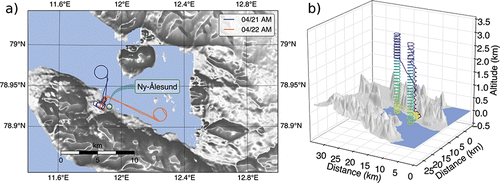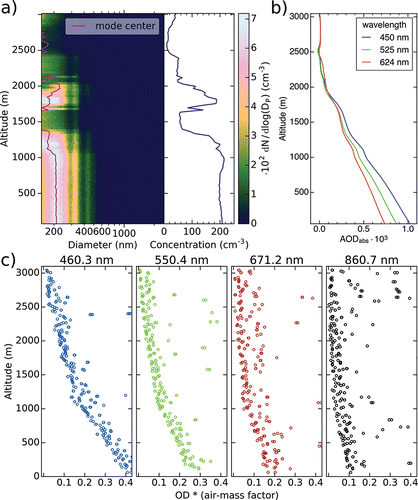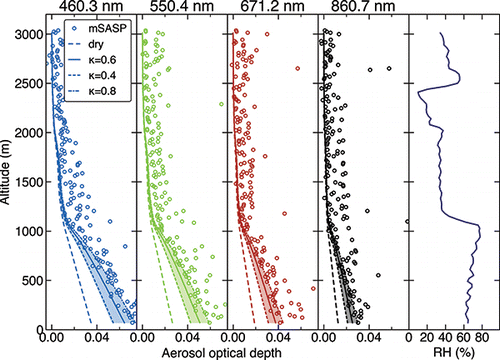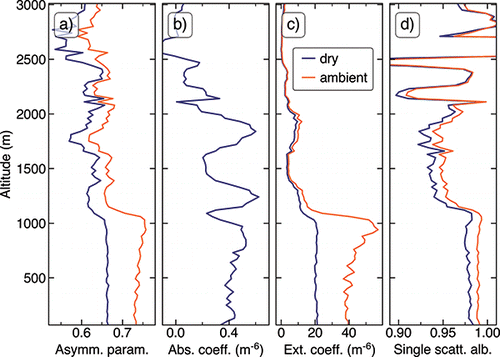Figures & data
Figure 1. Topview (a) and 3d view (b) of flight paths plotted on a map of Kongsfjorden and the surrounding terrain. Elevation data are taken from ASTER GDEM (ASTER GDEM is a product of METI and NASA).

Figure 2. (a)(left) Vertical profile of particle size distributions and (right) particle concentration derived from size distributions recorded by POPS. (b) Accumulated AOD from the top of the flight pass for the three wavelengths measured by BMI ABS. (c) Accumulated
from the top of the flight path measured by miniSASP. Each plot shows results for one of the four wavelength channels.

Figure 3. Illustration of the absence of a coarse mode and the limited contribution of particles outside POPS’s detection range to the overall scattering coefficient. (a) Size distributions collected by POPS during flight (dark [blue]) and an APS instrument located in the Gruvebadet ground station (light [orange]). (b) Bin-wise scattering coefficients of the two size distributions at a wavelength of 550 nm. Note, narrow features in (a) and (b) are artifacts intrinsic to optical sizing techniques. They are particularly pronounced in POPS measurements due to the short laser wavelength. See Gao et al. (Citation2016) for details.
![Figure 3. Illustration of the absence of a coarse mode and the limited contribution of particles outside POPS’s detection range to the overall scattering coefficient. (a) Size distributions collected by POPS during flight (dark [blue]) and an APS instrument located in the Gruvebadet ground station (light [orange]). (b) Bin-wise scattering coefficients of the two size distributions at a wavelength of 550 nm. Note, narrow features in (a) and (b) are artifacts intrinsic to optical sizing techniques. They are particularly pronounced in POPS measurements due to the short laser wavelength. See Gao et al. (Citation2016) for details.](/cms/asset/01aa00d2-ca92-4484-80bf-1affca063222/uast_a_1296103_f0003_oc.gif)
Figure 4. Comparison of vertical profiles of AOD measured by miniSASP (symbols) and derived from size distributions measured by POPS (lines). Subplots are results for the different wavelength channels with the wavelength given in the title and the relative humidity. We assumed different hygroscopicities for the size distribution-derived AOD values, none/dry (dashes), (solid),
(dots), and
(dash-dotted). Shaded areas mark the uncertainty interval for the size distribution-derived AOD values in case of
.

Figure 5. Vertical profiles of further aerosol properties that can be derived from measured datasets, (a) asymmetry parameter, (b) absorption coefficient, (c) extinction coefficient, and (d) single scattering albedo. Dark (blue) and light (orange) lines are for dry and ambient conditions, respectively, where the latter was considered by applying hygroscopic growth according to ambient RH and .

